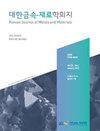Improved Thermoelectric Performance of Cu3Sb1−x−ySnxInySe4 Permingeatites Double-Doped with Sn and In
IF 1.4
4区 材料科学
Q4 MATERIALS SCIENCE, MULTIDISCIPLINARY
引用次数: 0
Abstract
Cu–Sb–Se ternary chalcogenide compounds composed of earth-abundant low-toxicity elements are attracting attention as economical and ecofriendly semiconductors. Among them, permingeatite (Cu3SbSe4) is a potential thermoelectric material with high Seebeck coefficient and low lattice thermal conductivity. However, it is necessary to improve its thermoelectric properties through doping, as it has low electrical conductivity due to its low intrinsic carrier concentration. In this study, samples of Cu3Sb1−x−ySnxInySe4 (0.02 ≤ x ≤ 0.08 and 0.04 ≤ y ≤ 0.06) double-doped with In (group 13 element) and Sn (group 14 element) at the Sb (group 15 element) sites of permingeatite were synthesized and their thermoelectric performances were evaluated. All samples exhibited a single phase of permingeatite with tetragonal structure, and high relative densities of 97.4–98.9%. The lattice constants of the a- and c-axes were 0.5651–0.5654 and 1.1249–1.1257 nm, respectively, owing to the successful substitution of Sn and In at the Sb sites. As the doping concentrations of Sn and In increased, the carrier (hole) concentration increased. Thus, the Seebeck coefficient decreased, while the electrical and thermal conductivities increased. Sn doping was found to be more effective than In doping. Because Cu3Sb0.96−xSnxIn0.04Se4 exhibits higher Seebeck coefficients than Cu3Sb0.94−xSnxIn0.06Se4, larger power factors and higher dimensionless figures of merit (ZTs) were achieved for the Cu3Sb0.96−xSnxIn0.04Se4 specimens. Cu3Sb0.92Sn0.04In0.04Se4 achieved a maximum ZT of 0.59 at 623 K, based on its Seebeck coefficient of 161 µVK−1, electrical conductivity of 4.69 × 104 Sm−1, thermal conductivity of 0.77 Wm−1K−1, and power factor of 1.22 mWm−1K−2.Sn和In双掺杂Cu3Sb1−x−ySnxInySe4铁电体热电性能的改进
由地球上丰富的低毒元素组成的Cu–Sb–Se三元硫族化合物作为经济环保的半导体受到关注。其中,透辉石(Cu3SbSe4)是一种具有高塞贝克系数和低晶格热导率的潜在热电材料。然而,有必要通过掺杂来改善其热电性能,因为它由于其低的本征载流子浓度而具有低电导率。在本研究中,合成了Cu3Sb1−x−ySnxInySe4(0.02≤x≤0.08和0.04≤y≤0.06)样品,并对其热电性能进行了评估。所有样品均表现出四方结构的单斜辉石相,相对密度高达97.4–98.9%。由于Sn和In在Sb位置的成功取代,a轴和c轴的晶格常数分别为0.5651–0.5654和1.1249–1.1257 nm。随着Sn和In掺杂浓度的增加,载流子(空穴)浓度增加。因此,塞贝克系数降低,而电导率和热导率增加。发现Sn掺杂比In掺杂更有效。由于Cu3Sb0.96−xSnxIn0.04Se4表现出比Cu3Sb00.94−xSnxMin0.06Se4更高的塞贝克系数,因此Cu3Sb0.906−xSnxIn0.04Se4试样获得了更大的功率因数和更高的无量纲品质因数(ZTs)。Cu3Sb0.92Sn0.04In0.04Se4的塞贝克系数为161µVK−1,电导率为4.69×104 Sm−1,热导率为0.77 Wm−1K−1和功率因数为1.22 mWm−1K−2,在623 K时实现了0.59的最大ZT。
本文章由计算机程序翻译,如有差异,请以英文原文为准。
求助全文
约1分钟内获得全文
求助全文
来源期刊

Korean Journal of Metals and Materials
MATERIALS SCIENCE, MULTIDISCIPLINARY-METALLURGY & METALLURGICAL ENGINEERING
CiteScore
1.80
自引率
58.30%
发文量
100
审稿时长
4-8 weeks
期刊介绍:
The Korean Journal of Metals and Materials is a representative Korean-language journal of the Korean Institute of Metals and Materials (KIM); it publishes domestic and foreign academic papers related to metals and materials, in abroad range of fields from metals and materials to nano-materials, biomaterials, functional materials, energy materials, and new materials, and its official ISO designation is Korean J. Met. Mater.
 求助内容:
求助内容: 应助结果提醒方式:
应助结果提醒方式:


